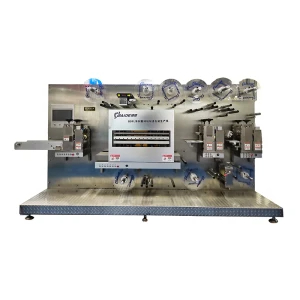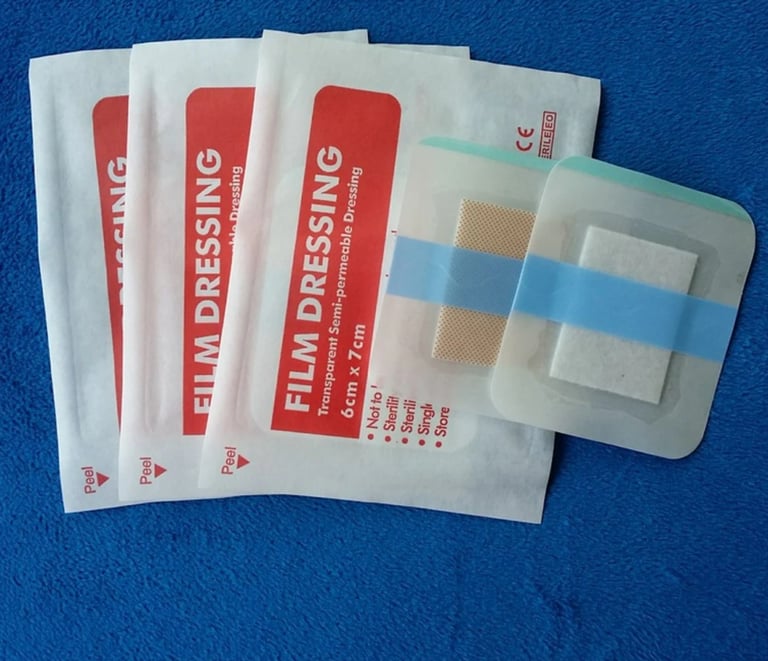Next-Gen Medical Device Manufacturing: From Raw Materials to Packaged Dressings — The Leon Machinery Edge
LEON MACHINERY
10/17/20257 min read


Introduction
In the fast-evolving world of medical device manufacturing, every second counts. The global demand for wound care, adhesive bandages, hydrogel patches, and disposables has surged, and manufacturers must push the boundaries of automation, reliability, and scalability. But automation is not just about faster machines — it is about designing a fully integrated, intelligently coordinated production line that ensures consistency, traceability, and quality.
Leon Machinery brings you a compelling vision: a seamless, automated production ecosystem covering everything from raw materials to final packaged products. In this article, we’ll dive deep into the machines and technologies involved — Wound Dressing Production Machine, IV Dressing Production Machine, Adhesive Band Aid Production Machine, Hydrocolloid Dressing Machine, Hydrogel Coating Machine, ECG & TENS Electrodes Machine, Medical Tapes Production Line, Four Side Sealing Packing Machine, Cartooning (Cartoning) Line Solutions, and the raw materials feeding into them.
We will explore how each machine fits into a synchronized production line, the challenges of integration, and the benefits — in yield, quality, and regulatory compliance.
The Role of Raw Materials in Medical Dressing Production
At the heart of any high-performance manufacturing setup lie the raw materials. For example, in wound care dressings, you might need nonwoven substrates, superabsorbent polymers (SAP), hydrogel precursors, adhesive layers (acrylic, silicone, PU, or pressure-sensitive), backing films, and release liners. The purity, consistency, moisture content, and particle size distribution of these raw materials directly affect downstream processes.
You can’t run a hydrocolloid dressing line if your gel precursor carries too much moisture or imbalance of ionic components. You can’t reliably do vacuum packaging if residual outgassing from raw films remains uncontrolled.
Thus, Leon Machinery begins by defining raw material qualification protocols, storage systems (e.g. dessicators, dry rooms), and automatic feeders that precisely dose these materials into downstream machines. This upstream control reduces rejects, rework, and variability.
Wound Dressing Production Machine
The Wound Dressing Production Machine is often the central “hub” in a dressing line. It may combine layering, lamination, cutting, and sterilization steps. In practical terms, you might begin by feeding a nonwoven substrate, then layering absorbent cores, adhesive, and backing films. The machine must maintain precise alignment, tension control, and web handling quality.
Leon Machinery’s wound dressing machine can be modular — you can add optional modules such as embossing, perforation, or slitting. It supports configurations for gauze, foam, alginate, or composite dressings. The machine also logs sensor data (tension, temperature, humidity) in real time to ensure process stability.
Key challenges include: web flutter, misalignment, edge trimming, burrs, and maintaining lamination bond strength. Leon Machinery addresses these via closed‐loop sensors and feedback controls.
IV Dressing Production Machine
IV dressings (transparent films that secure IV catheter sites) demand clarity, adhesive uniformity, and precision. The IV Dressing Production Machine often starts from a film substrate (e.g. PU, TPU) and must deposit adhesive in precise patterns, laminate a nonwoven border, and cut into final shapes (rectangular, star, fenestration, etc.).
The cut shapes may require rotary or flying shear devices to avoid stopping the web. Then a release liner is applied and trimmed. The machine needs to avoid adhesive bleeding, edge delamination, or optical defects (oxidation spots, haze).
Leon Machinery ensures that the IV dressing line is tightly integrated with upstream and downstream modules, maintaining synchrony in web speed, tension, and registration. If you need an additional layer (e.g. absorbent pad under the fenestration), the modular design allows insertion of a mini wound dressing sub-unit.
Adhesive Band Aid Production Machine
This is among the more familiar machines to many. The Adhesive Band Aid Production Machine (often called a “plaster line”) must handle substrate, adhesive coating, backing, slitting, die cutting, liner unrolling, and final packaging. The tricky part is adhesive spreading (knife, roller, slot die), ensuring even coat weight, and avoiding “tailing” or smearing.
Leon Machinery’s band aid machine allows multi-lane formats. You can produce multiple strips per cycle. The machine also supports pad insertion for gauze center, folding, and overwrapping. It registers each strip for traceability — you can optionally incorporate a code printer or QR code marker on each bandage.
Short cycle times matter, and Leon’s line ensures that the adhesive application, curing (if necessary), die cutting, and liner lamination are all in sync.
Hydrocolloid Dressing Machine
Hydrocolloid dressings are typically composed of hydrocolloid gel, tackifier, and substrate layers. They are semi-occlusive and often more complex to produce due to viscosity, tack, and storage stability. The Hydrocolloid Dressing Machine handles the mixing of gel precursors, coating or casting onto substrates, lamination, cutting, and packaging.
Controlling viscosity, gel uniformity, thickness, and margin consistency is critical. Leon Machinery uses precision slot die coaters (or reverse roll coaters) with temperature control to maintain gel rheology. The coated web then passes through a gelling/drying tunnel before trimming.
Another challenge: preventing gel squeeze-out on cutting edges. Leon’s line includes an edge sealing zone (hot air or IR) to reduce leakage and ensure clean edges.
Hydrogel Coating Machine
A submodule in many dressing lines, the Hydrogel Coating Machine deposits the hydrogel layer onto a substrate. It might be a slot die, gravure, reverse roll, or Mayer rod coater. The machine ensures uniform gel thickness, accurate registration, and controlled environment (humidity, temperature).
Leon’s hydrogel coater module also supports inline viscosity measurement, closed‐loop flow control, and solvent recovery (if applicable). Post coating, a partial drying step (e.g. IR or forced air) may reduce solvent or water content before lamination.
ECG & TENS Electrodes Machine
This is a specialized branch but fits well in medical consumables manufacturing. The ECG & TENS Electrodes Machine fabricates electrode patches: conductive layer (e.g. Ag/AgCl ink, carbon, hydrogel) on substrate, adhesive border, foam or gel pad, and liner. Some electrodes may require punching, lamination, and packaging.
Challenges: precise registration of conductive patterns, avoiding smudging or short circuits, controlling electrode impedance and gel stability. Leon Machinery integrates printing, coating, lamination, laser or die cutting, and final inspection in a compact line. Some variants may incorporate conductive wire bonding or snap button crimping.
Medical Tapes Production Line
Medical Tapes cover many types — microporous tape, fibrous tape, adhesive fabric tape, paper tape, surgical tape, etc. A tape line typically includes unwinding, adhesive coating, drying, curing (if needed), laminating, slitting, and rewind or die cut.
Leon Machinery’s tape line supports multiple adhesive chemistries: acrylic, silicone, hot melt, or water-based adhesives. The line includes a web tension control system, corona treatment (optional), drying ovens, and precise slitters (rotary, razor). The finished tapes can be rewound in rolls or die-cut into shapes for bandages or dressings.
Four Side Sealing Packing Machine
Once the medical articles (dressings, bandages, electrode patches) are produced, they often require packaging in sealed foil or film pouches. The Four Side Sealing Packing Machine (also called 4-side seal pouch opener/sealer) handles pouch forming, insertion, sealing (top, bottom, left, right), and optionally date / lot coding.
Leon’s 4-side sealing units support heat seal, ultrasonic, or impulse sealing. They also can integrate vacuum or gas flush (e.g. nitrogen) if needed. The machine includes precision film feeding, registration, pull belts, and trim ejection of waste edges. It works synchronously with upstream product feeding, detecting timing to insert the correct article into each pouch.
Cartoning (Cartooning) Line Solution
After pouches are sealed, many customers require secondary packaging: cartons or boxes. The Cartoning Line picks and erects cartons, inserts the pouches (single or multiple), closes flaps, and may apply tamper-evident seals or shrink wrap.
Leon’s cartoning solution can work either in line (inline with pouch machines) or as a stand-alone module. It supports automatic carton magazine feeding, flap folding (bottom and top), insertion via robotic arms or pushing bars, and closing. You can also integrate serialization (barcode or QR coding) here.
Building the Integrated Production Line
To ensure smooth flow, Leon Machinery designs each module (coating, lamination, cutting, packaging) with matched web speed, tension control, registration, and buffer zones. Between modules, intermediate buffer unwind/rewind stations or dancing rollers absorb tension variation.
A central PLC + SCADA system controls the entire line: speed coordination, interlocks, alarms, recipe management, and data logging. Operators can switch product recipes via HMI, change format parts, and execute cleaning or maintenance procedures.
Leon often provides the line in modular form, so users can gradually expand from, say, adhesive band aid module to wound dressing to IV dressing. The modular approach reduces CAPEX risk.
Challenges & Solutions in Integration
Challenge: Synchronization across modules
If coating runs at 100 m/min but sealing can handle only 80 m/min, bottlenecks arise. Leon solves this by capacity matching, buffer zones, and upgradable modules.
Challenge: Web dynamics & tension control
At high speeds, web flutter, misfeeds, and delamination are common. Leon uses closed-loop tension controllers, dancer rollers, automatic tension feedback, and optimized web paths.
Challenge: Environmental control
Humidity and temperature fluctuations can affect adhesives, gels, or film expansion. Leon provides cleanrooms or controlled enclosures for sensitive modules like hydrogel deposition or electrode printing.
Challenge: Changeovers & format flexibility
Switching from one product size or shape to another requires quick changeover. Leon supplies quick-change dies, motorized adjustment, recipe memory, and layout guides.
Challenge: Traceability & regulatory compliance
Medical device regulators demand batch traceability, audit trails, sterilization validation, and documentation. Leon’s control software supports batch tracking, timestamping, alarms, and data export for regulatory submission (e.g. 21 CFR part 11 compatibility for some markets).
Why Choose Leon Machinery?
Holistic Offering — from raw material feeding to packaging, Leon gives you a one-stop integrated solution.
Modularity — grow your line step by step, adding modules as demand increases.
Customization — Leon can adapt machines for your product’s size, adhesive type, gel chemistry, etc.
Support & Service — remote monitoring, spare parts sourcing, and field installation assistance.
Performance & Yield — precise control, minimized rejects, and streamlined flow reduce cost per unit.
Case Study (Hypothetical Example)
Imagine a company wants to produce hydrocolloid wound dressings at 5,000 units per hour, packaged in sealed pouches, then cartoned in 20-unit boxes. With Leon’s proposed line:
Raw material feeders dose adhesive, gel precursors, substrate
Hydrogel coating module places gel layer on substrate
Lamination with backing and release liner
Web passing through gelling/drying tunnel
Die cutting into individual dressings
Four side sealing of each dressing in foil pouch
Cartoning: 20 pouches per box
Final labeling, serialization, and batch coding
The entire line runs at matched speed (say, 100 m/min), with buffer zones to absorb variance. Data logging ensures batch traceability. Suppose the reject rate is under 0.5%. The throughput, margin, and regulatory compliance make the investment worthwhile.
Tips for Implementation
Conduct a line survey: footprint, power, utilities (air, vacuum, nitrogen, chilled water).
Prepare a cleanroom or dust-controlled environment for sensitive modules.
Plan for spare parts, consumables, and preventive maintenance.
Validate machine performance (IQ/OQ/PQ) during acceptance.
Train operators and maintenance staff thoroughly.
Collect operational data immediately to tune process recipes.
Conclusion
In the current medical manufacturing environment, automation is no longer optional — it’s essential. But simply buying machines is not enough. The key is integration, coordination, and intelligent control. Leon Machinery offers a visionary approach: an end-to-end, modular production line covering raw materials, coating, lamination, cutting, packaging, and cartoning — all synchronized and optimized.
If you are planning a new production facility or upgrading your existing line, Leon Machinery can be your partner — from design and installation to support and service.
Contact:
Leon Machinery
WhatsApp: +86 181 3677 3114
Email: leonxu0317@gmail.com
Topic Tags
#WoundDressing #IVDressing #AdhesiveBandAid #Hydrocolloid #Hydrogel #Electrodes #MedicalTapes #PackagingLine #MedicalDeviceManufacturing #LeonMachinery


